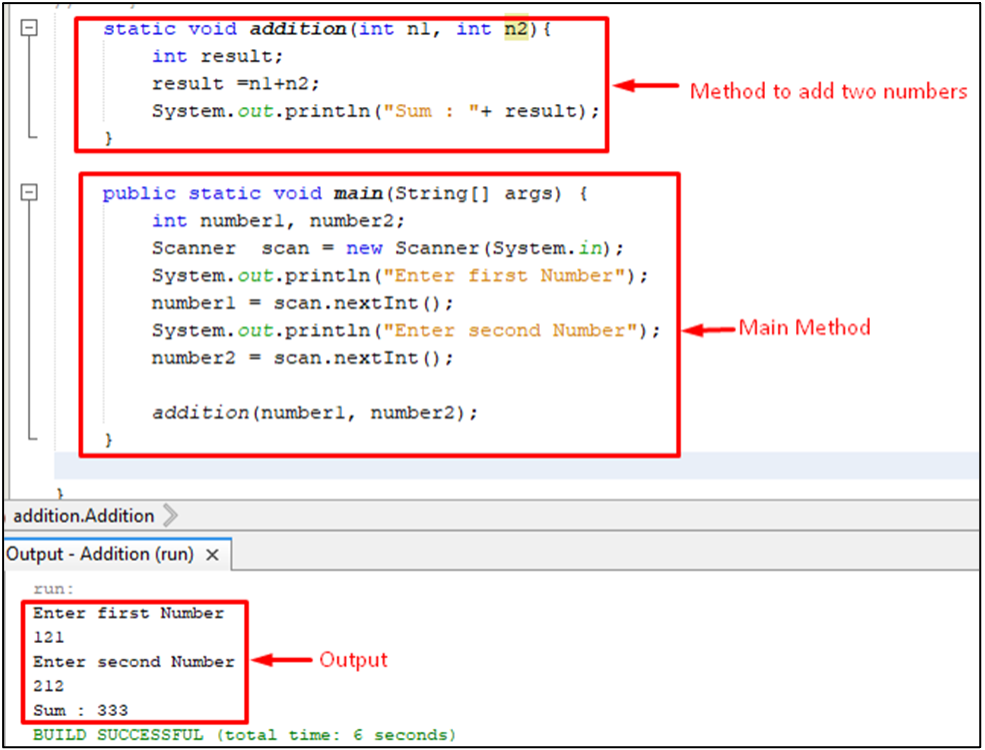- What is a Java Method
- Basic Syntax of Java Method
- How to Create and Call a Method
- How to Pass Parameter(s) to a Method
So, let’s start!
Java Method/Function
In Java, a method is nothing but a unit or a block of code that is used to perform a specific task/operation. A Java method runs only when we call it and once a method is defined in a program, it can be used anywhere within the scope of the method.
Syntax of Java Method
The below-given snippet provides the basic syntax of the user-defined Java method:
{
//statements
}
A Java method can have a returnType, methodName, and parameter list.
- The returnType of the method can be void, a primitive type such as int, float, etc. or a reference type
- while a methodName can be any name written in camel case naming convention, followed by the parenthesis ().
- Within the parenthesis(), a single parameter or a list of parameters may or may not be passed.
How to Create and Call a Method
In Java, a method must be created within the class, and to do so all we have to do is define the function/method name followed by small brackets (). Let’s consider an example for a better understanding of how to create and call a user-defined method in java.
Example
This example will take two values from the user and add them using a user-defined method “sum”:
static void sum(){
int num1, num2, result;
Scanner scan = new Scanner(System.in);
System.out.println("Enter First Number");
num1 = scan.nextInt();
System.out.println("Enter Second Number");
num2 = scan.nextInt();
result= num1+num2;
System.out.println("Sum of two Numbers : " + result);
}
Now the method is successfully created and it’s time to call the method and to do so we will write the method’s name followed by parenthesis in the main method:
The below-given figure provides a complete code and output:
The above-snippet authenticates when we call the sum() function from the main method then it provides the sum of user-entered values.
How to Pass Parameter(s) to a Method
The value(s) can be passed to a method through the parameter(s) and these parameters serve as variables within a method. We have to pass the values as arguments when calling the method.
A parameterized method can have single or multiple parameters and all the parameters will be written within the parenthesis. In the case of multiple parameters, all the parameters must be separated with a comma.
The below-given example will provide a better understanding of how to pass the parameters to a method.
Example
This example will provide the sum of user-entered data and the data will be passed as parameters:
We create a function to add two numbers:
int result;
result = n1 + n2;
System.out.println("Sum : "+ result);
}
In the main method we take two values from the user:
And we passed the user-entered data as parameters to the sum function and call it from the main method.
The complete code and the respective output is shown in the below-given figure:
Let’s conclude how the above program works, two values are taken from the user and passed them as arguments to the addition method. The addition method adds both the values and displays the result.
Conclusion
In java, a user-defined method can be either a parameterized or a non-parameterized method. The non-parameterized methods don’t take any data as parameters. On the other hand, the parameterized method takes a parameter or a list of the parameters that receive the respective values from the method calling. This write-up presents a comprehensive overview of what is java method, and how to create and call a method. Moreover, it provides a complete guide for the parameterized Java methods.


